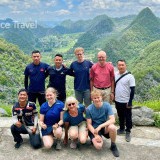Dong Van
Dong Van is a mountainous province of Ha Giang, which is famous for Dong Van karst plateau park. Telling about stone plateau, many people easily imagine a barren landscape with only rocks and mountains. On the contrary, this land nurtures many beautiful, colorful and sweet flowers. Therefore, the beauty of Dong Van stone plateau is a combined place that fulls of majestic and romantic specialities
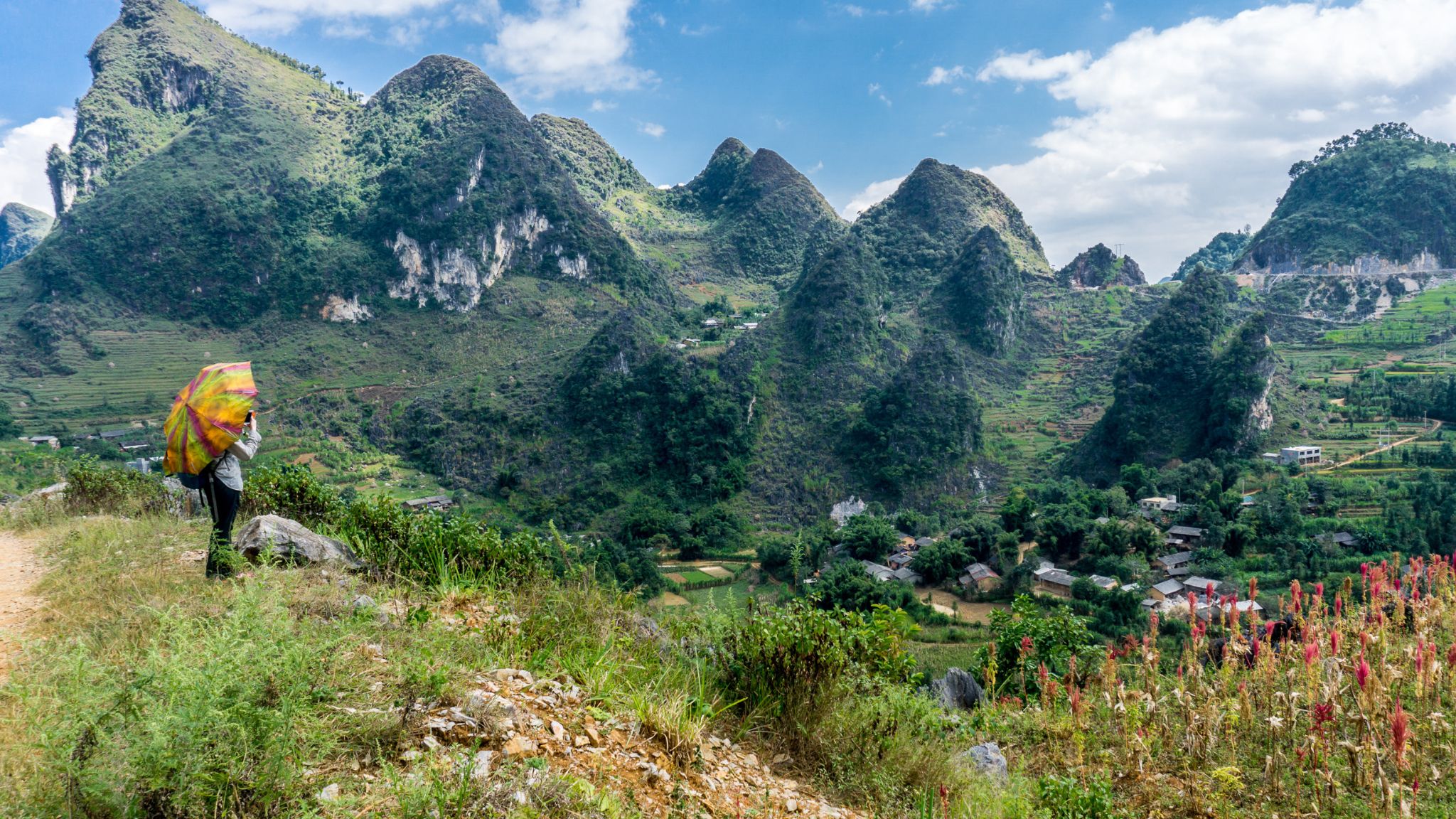
- Why Dong Van Should Be on Your Vietnam Bucket List
- Where is Dong Van?
- Best Time to Visit Dong Van
- How to Get to Dong Van from Hanoi
- Where to Stay in Dong Van
- Top Things to Do in Dong Van
- Recommended 4-Day Dong Van Itinerary
- Food in Dong Van: What You Should Try
- Budget Planner For You
- FAQs About Dong Van Travel
Why Dong Van Should Be on Your Vietnam Bucket List
“Standing on the Ma Pi Leng Pass with the Nho Que River winding below, you’ll understand why Dong Van is often called Vietnam’s final frontier.” This rugged mountain town sits at the heart of the Ha Giang Loop, surrounded by dramatic limestone peaks, ancient H’mong villages, and the UNESCO-listed Dong Van Karst Plateau Geopark.
We’ve explored every curve of these mountain roads, and trust us - few places in Vietnam offer such a perfect blend of raw beauty and authentic culture.
- True off-the-beaten-path adventure - Remote and untouched, Dong Van offers a rare glimpse into Vietnam’s wild northern frontier.
- Authentic travel experiences - Ride the Ha Giang Loop, stay in family-run homestays, and enjoy local dishes made from homegrown ingredients.
- UNESCO-recognized landscape - The Dong Van Karst Plateau Geopark showcases 400 million years of geological history.
- A paradise for photographers - Golden rice terraces, misty mountain passes, and vibrant markets - every corner is picture-perfect.
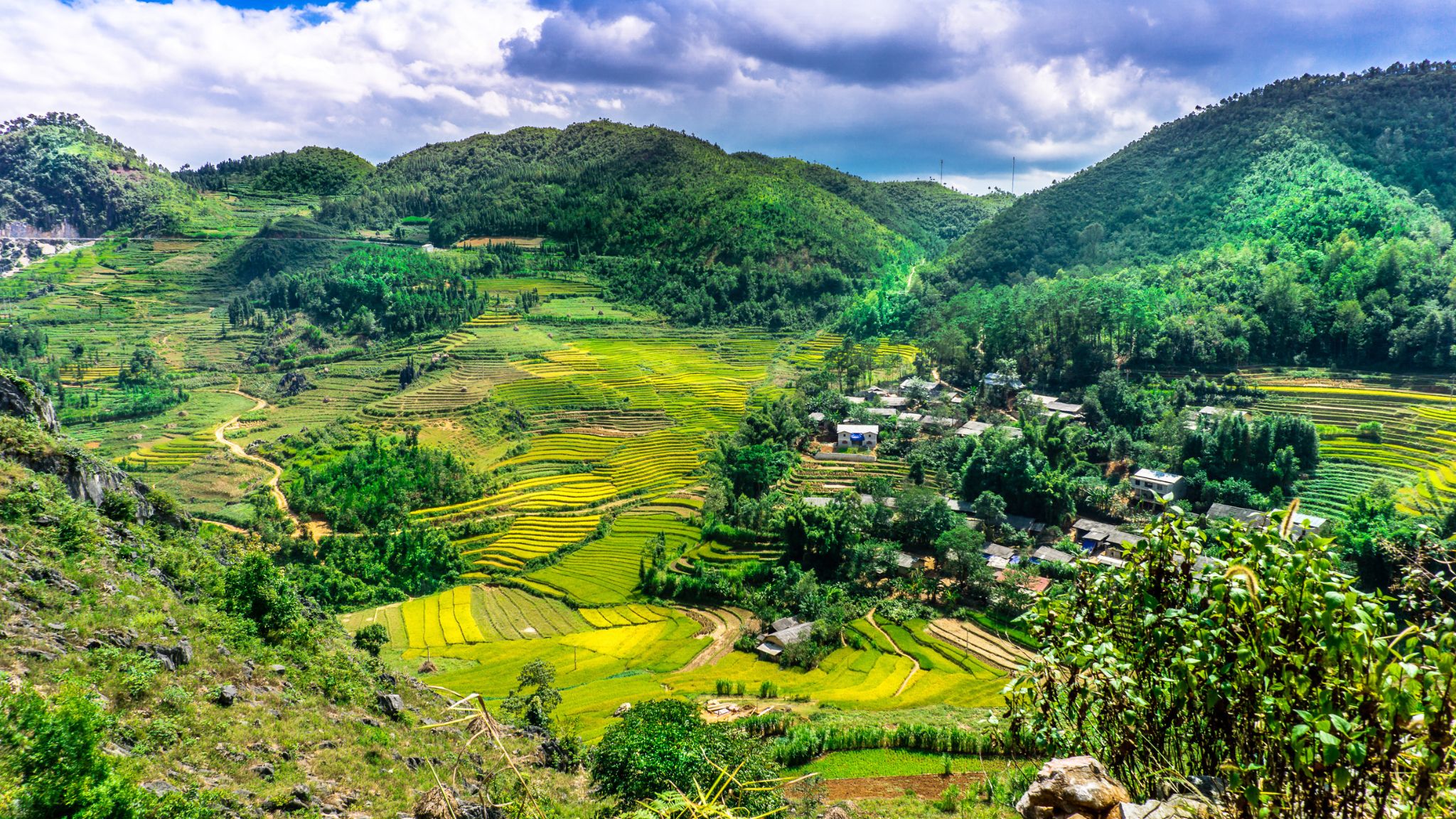
Dong Van Captivates With Its Majestic Mountains, Winding Passes, And Ancient Stone Houses
Is Dong Van Worth It?
Yes, if you want Vietnam’s wild landscapes & authentic culture. But Dong Van isn’t for everyone: roads are challenging, facilities basic - but the reward is unmatched
Where is Dong Van?
Dong Van locates at the north pole of Vietnam, this is the highest protruding point on the map of Vietnam. Dong Van is 155km apart from Ha Giang city, where Lung Cu flagpole marks the extreme North of our country, making the border division between China and Vietnam. Dong Van stone plateau is at an average altitude of 1,000 - 1,600m above the sea level, with an area of nearly 2,356km² stretching across the area of 4 districts: Quan Ba, Yen Minh, Meo Vac and Dong Van of Ha Giang province.

Dong Van Karst Plateau Geopark
This is one of the special limestone areas of the country, containing historical information of the earth's crust development. Dong Van contains 80% of the limestone area, made up by various environmental conditions and development stages, lasting hundred million years. That’s why Dong Van is well-known for stunning landscapes including mountains, majestic caves, colorful flowers in forests.
The most beautiful tourist attraction is the old town of Dong Van. This must be very enjoyable and excited when wandering in the old town to explore the culture, cuisine and traditions of the highland people. Such a good experience when discovering this ancient town.
Dong Van Ancient Street is a nearly one-kilometer long street that was formed nearly a century ago, with the typical architectural features of the highland people, such as yin and yang roofs, natural stone floors and yin and yang tiles. The ancient town has more than 40 houses being 100-300 years old, in which the house of Luong family is thought to be the oldest. In every full-moon nights, the street is colorfully lightened with red lanterns of various sizes. It also serves food and has other cultural activities in those days.
Best Time to Visit Dong Van
The best time to visit Dong Van is from September to November, when the weather is cool and dry, and the mountains glow with golden rice terraces and blooming buckwheat flowers.
This is also the most photogenic season - perfect for scenic rides along Ma Pi Leng Pass and sunset walks through Dong Van Ancient Street. We always recommend booking accommodation early during this period, as local homestays fill up fast.
- If you visit in March, you’ll see peach and plum blossoms turning the valleys into a sea of pink and white - a dream for photographers.
- April brings the famous Khau Vai Love Market, one of Vietnam’s most unique cultural festivals.
- Winter (December to February) can be chilly, especially in the evenings, but it adds a misty charm to the landscape.
The weather changes quickly in the mountains, so you should pack a light jacket and raincoat - a small tip that will make your journey much more comfortable.
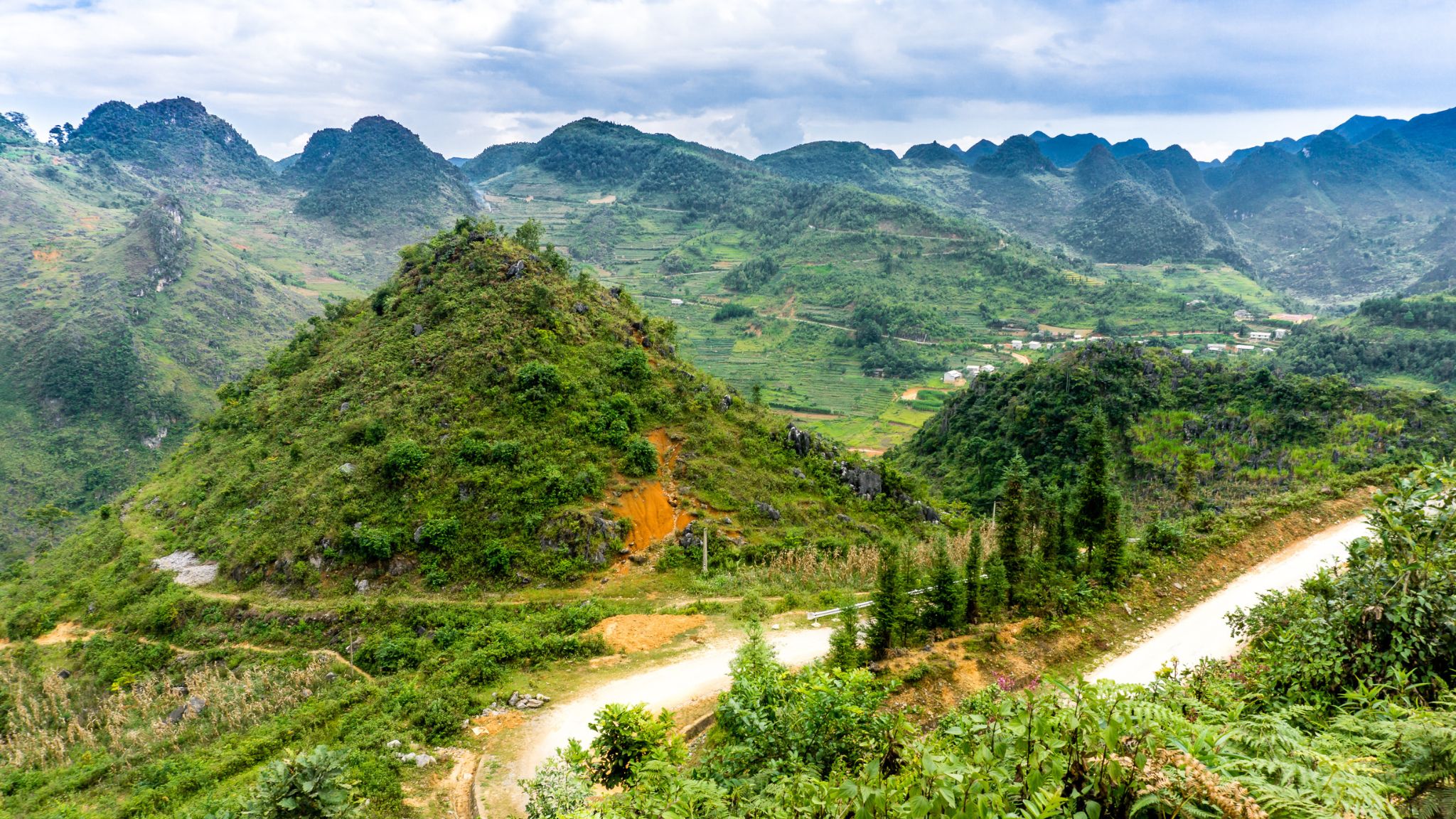
Best Time To Visit Dong Van Is From Sep To Nov For Cool Weather And Clear Views
How to Get to Dong Van from Hanoi
Reaching Dong Van from Hanoi is part of the adventure -the journey itself offers stunning scenery and a true taste of northern Vietnam. There are several ways to get there, depending on your comfort level and travel style.
Option 1: Bus to Ha Giang City + Motorbike or Car Tour
This is the most common and budget-friendly option. Take an overnight sleeper bus (7-8 hours) from Hanoi to Ha Giang City, then start your Ha Giang Loop adventure by renting a motorbike or joining a guided car/motorbike tour.
We recommend this for travelers who want a mix of adventure and flexibility -but if you’re new to mountain riding, choose a local driver or “easy rider” for safety.
Option 2: Private Car with Driver
If comfort is your priority, book a private car transfer with BestPrice Travel. The drive takes about 8-9 hours, and you’ll enjoy flexible stops for photos, food, and short breaks. This is the best choice for couples, families, or travelers who prefer a smooth and worry-free experience.
Option 3: Self-Drive (for Experienced Riders Only)
Driving yourself on the Ha Giang Loop is possible, but only recommended for confident, licensed riders familiar with mountain roads. The routes are breathtaking but steep and winding, with sharp turns and unpredictable weather. We strongly advise having proper travel insurance and checking your motorbike carefully before departure.
Where to Stay in Dong Van
Accommodation in Dong Van ranges from simple guesthouses to cozy ethnic homestays, giving you plenty of options depending on your travel style and comfort needs.
Most visitors stay in Dong Van Town, where you’ll find small hotels, local guesthouses, and restaurants within walking distance. Staying here is convenient if you want to explore the Dong Van Ancient Street in the evening or join the lively Sunday market early in the morning.
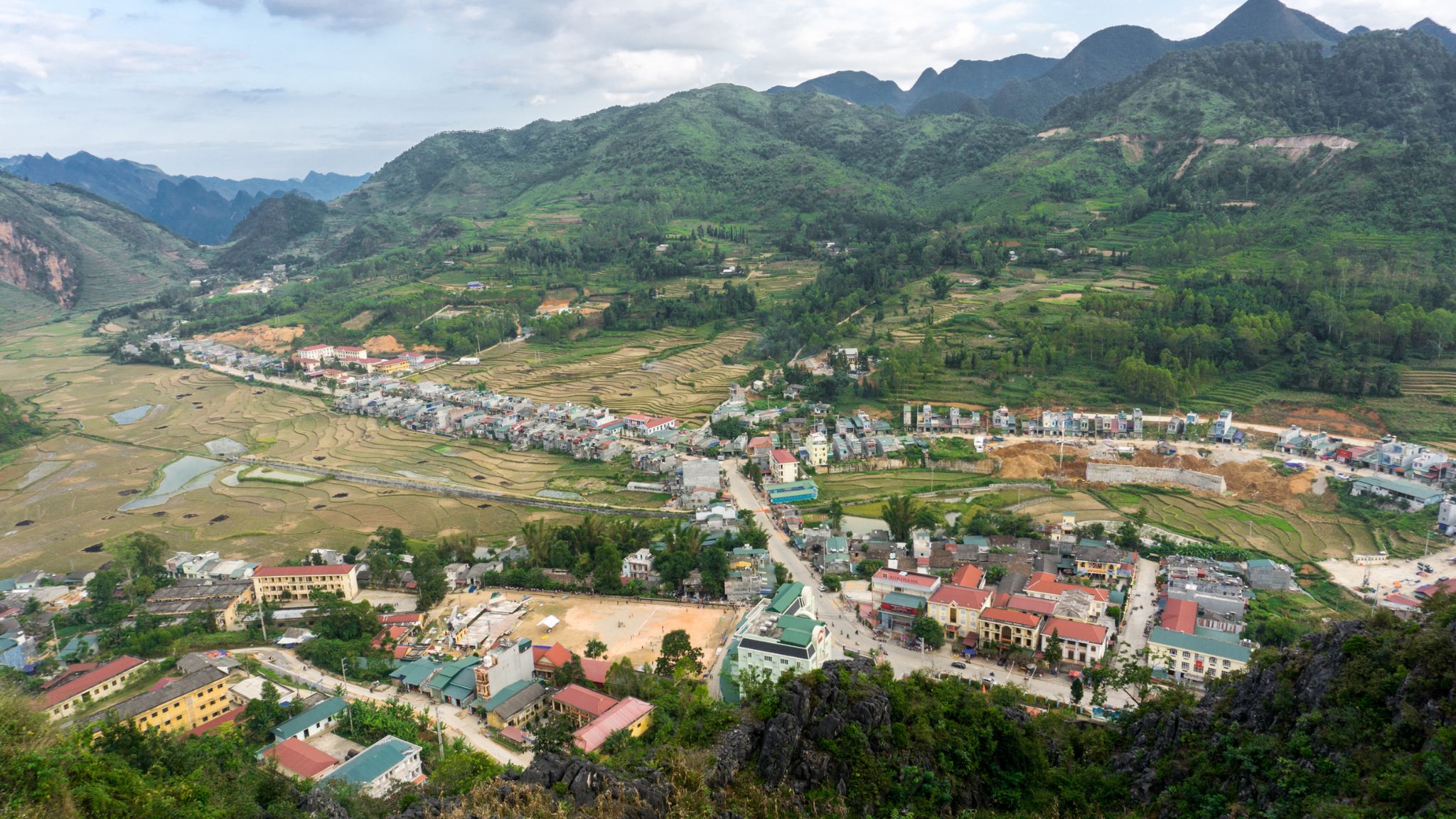
Dong Van Town Is A Charming Highland Town Surrounded By Rugged Mountains And Limestone Cliffs
If you prefer a more local experience, head to Ma Le or Lung Cu villages, where you can stay in authentic H’mong clay houses surrounded by mountains and rice fields. These traditional homestays offer a warm family atmosphere, home-cooked meals, and a glimpse into ethnic life - a highlight our travel experts always recommend.
BestPrice Travel Tip: Rooms fill up quickly during the buckwheat flower season (October-November) and Khau Vai Love Market (April), so we always suggest booking early to secure the best homestays or hotels.
Top Things to Do in Dong Van
There’s no shortage of unforgettable experiences in Dong Van -from dramatic mountain passes to colorful ethnic markets. Our travel experts have explored every corner of this region to bring you the must-do highlights below.
Conquer Ma Pi Leng Pass
This is Vietnam’s most breathtaking mountain pass, often called the “king of all passes.” The winding road hugs sheer cliffs with panoramic views of the Nho Que River far below -a view that never fails to amaze.
Visit early in the morning for the softest light and fewer vehicles - it’s perfect for photography and drone shots.
Take a Boat Trip on the Nho Que River
Glide along turquoise waters surrounded by the towering cliffs of Ma Pi Leng Canyon, one of Vietnam’s most scenic river valleys. Boats can be hired from Ta Lang Village, where locals operate small, safe tours.
Arrive before 9 AM to avoid crowds and bring a hat, sunscreen, and a waterproof bag for your phone or camera.
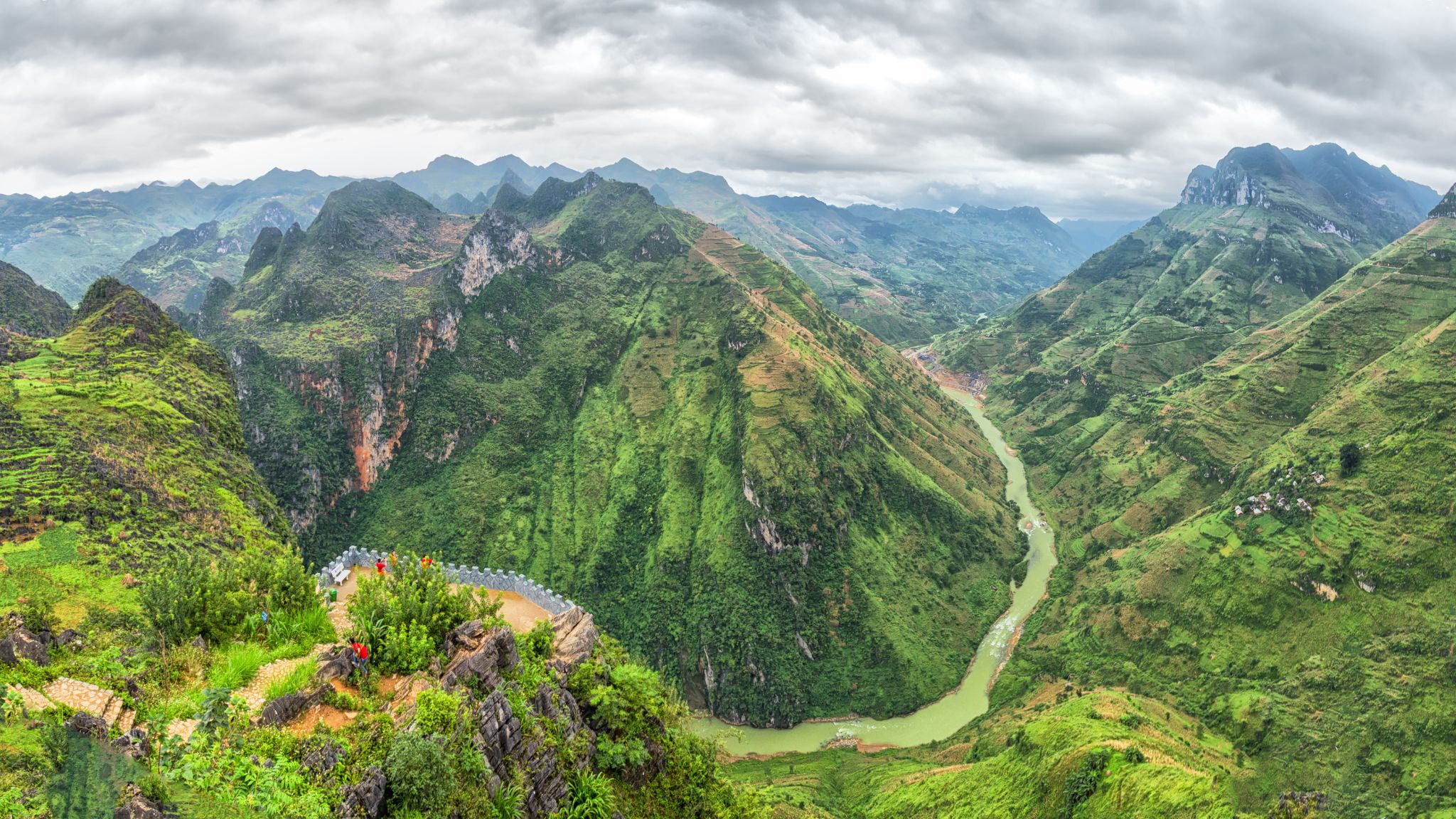
Take A Boat Trip On The Nho Que River To Enjoy Stunning Canyon Views And Emerald Waters
Explore Dong Van Old Quarter
The Dong Van Ancient Street is a charming mix of H’mong and Chinese-style stone houses, some dating back over a century. It’s lovely for an evening stroll, with local food stalls serving corn wine, buckwheat pancakes, and hot noodle soup.
Stay overnight nearby to enjoy the quarter after day-trippers leave- the quiet, lantern-lit streets feel magical.
Climb to Lung Cu Flag Tower - The North Pole of Vietnam
Standing at Vietnam’s northernmost point, the Lung Cu Flag Tower is a powerful national symbol and offers sweeping border views across to China. The climb takes about 20-30 minutes and is well worth the effort.
Bring water and wear sturdy shoes - the steps can be steep but manageable for most travelers.
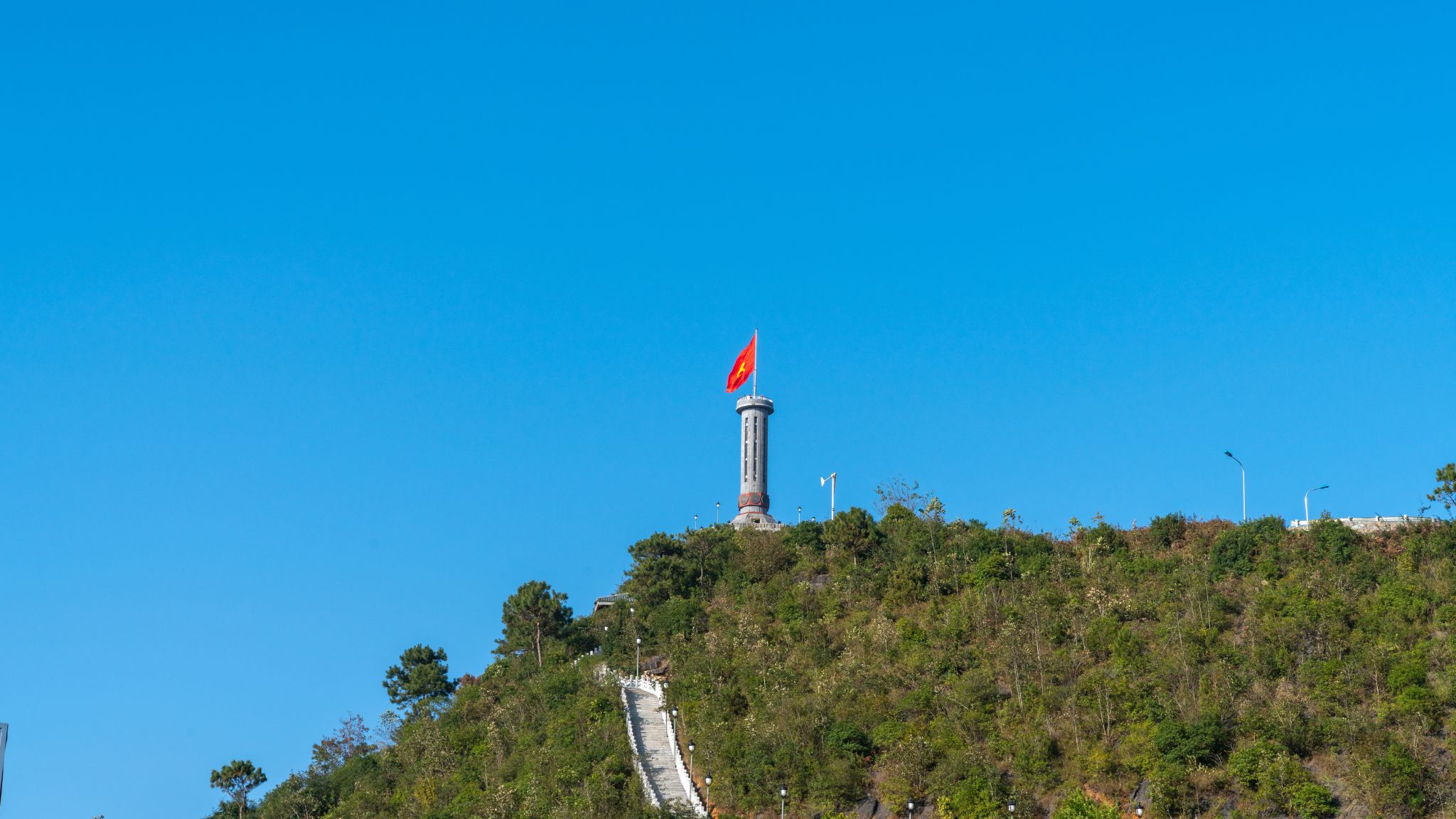
Lung Cu Flag Tower Marks Vietnam’s Northernmost Point With Stunning Panoramic Mountain Views
Visit the Ethnic Minority Markets
Dong Van’s weekly markets- including Meo Vac, Dong Van, and Lung Phin - are lively gatherings where ethnic groups trade goods, textiles, and livestock. You’ll see people in colorful traditional costumes, sharing food and stories.
Go early in the morning (around 6-7 AM) - most markets wind down by noon. Always ask before taking photos of locals.
Step Inside the Palace of the H’mong King (Vuong Palace)
This 100-year-old stone and wood mansion once belonged to the royal H’mong family and showcases a stunning blend of French, Chinese, and H’mong architecture. It’s small but rich in history and beautifully preserved.
Combine this stop with your ride from Yen Minh to Dong Van - it’s right on the way and offers great photo opportunities.
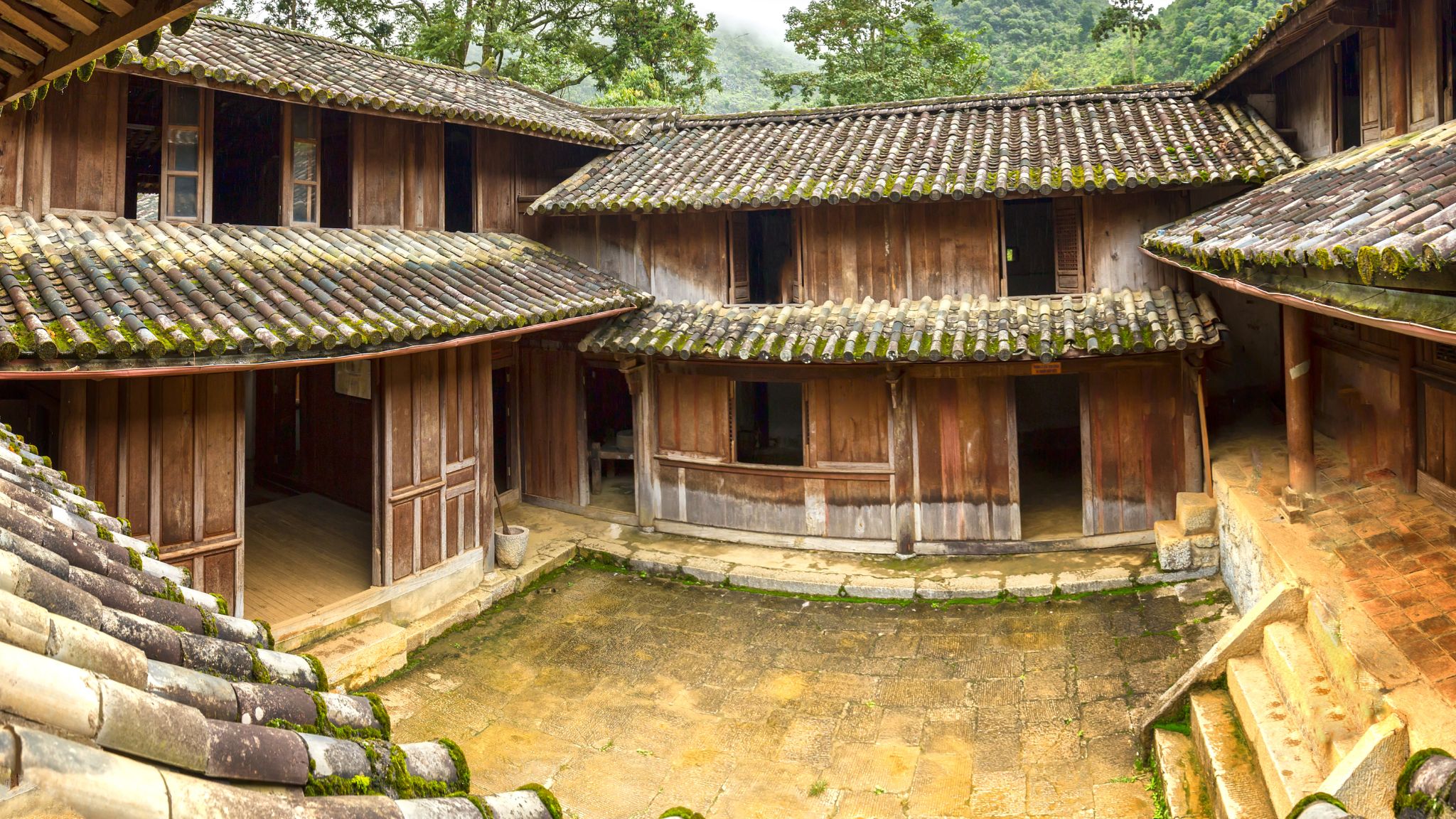
The Palace Of The H’mong King (Vuong Palace) Showcases Unique H’mong Architecture
Experience the Khau Vai Love Market (April)
Held once a year in April, this unique event brings together ethnic couples - some reuniting with old lovers just for one day. It’s a beautiful and emotional celebration of love, tradition, and human connection.
Book accommodation early - the town gets busy during the festival. It’s one of the most meaningful cultural events in northern Vietnam.
Recommended 4-Day Dong Van Itinerary
If you’re planning to explore Ha Giang’s legendary loop, 4 days is the sweet spot. It gives you time to enjoy the stunning landscapes, relax at homestays, and visit all the highlights- from Ma Pi Leng Pass to Dong Van Old Quarter and Du Gia Waterfall.
Below, our travel experts share how to make the most of your trip, plus what to prepare before you go.
Before You Go - Essential Planning & Packing
- Time Required - You’ll need around 4 days to truly soak in the experience. Most top travel guides - including Lonely Planet - recommend 3-4 days for the full journey.
- Book Transport Early - Sleeper buses and limousines from Hanoi to Ha Giang often sell out in peak season (especially during the buckwheat flower and festival months). If you prefer a seamless experience, book a private transfer or guided tour with BestPrice Travel- ideal for first-time travelers.
- Cash & Cards - ATMs are rare once you’re on the loop. Always carry enough Vietnamese dong for small payments.
- Clothing - Pack layered clothes, sturdy shoes, a light rain jacket, sunhat, sunscreen, power bank, and a small first-aid kit. For photography, bring a wide-angle lens for Ma Pi Leng Pass!
- Health & Safety - The mountain roads are steep and winding, so avoid riding after dark. If you’re not comfortable driving, go with a local driver - it’s safer and lets you enjoy the views without stress.
Day 1: Hanoi - Ha Giang (Approx. 300 km)
Your adventure begins with a transfer from Hanoi Old Quarter to the bus station. From there, you can choose between limousines, sleeper buses, or private transfers, depending on your comfort and schedule.
- Morning /Afternoon Pickups: Great for those who prefer daytime travel.
- Evening /Overnight Buses: Most popular with backpackers - you’ll save one night of accommodation and arrive early to start the loop.
BestPrice Travel Tip: If you’re traveling independently, book your Hanoi-Ha Giang ticket at least a day in advance. For a worry-free option, our team can help arrange transport, local guides, and your entire Ha Giang Loop itinerary.
Day 2: Ha Giang - Quan Ba - Yen Minh - Dong Van (≈135 km total)
Arrive in Ha Giang City early morning (around 3:30-6:00 AM), check into a local hostel for a short rest, then enjoy a hearty Vietnamese breakfast with strong coffee and warm bánh mì before starting your loop.
The road to Dong Van is filled with stunning mountain views and ethnic villages. Stop at Quan Ba Heaven Gate for panoramic photos of the Twin Mountains, then continue through Yen Minh’s pine forest valley - one of the prettiest stretches on the route. Along the way, you’ll pass traditional H’mong houses, terraced fields, and local markets where few tourists go.
Day 3: Dong Van - Ma Pi Leng Pass - Nho Que River - Du Gia (≈95 km)
Start your morning in Dong Van around 7:30 AM after breakfast, and if it’s Sunday, visit the lively Dong Van Market. Then head toward the legendary Ma Pi Leng Pass, where the Sky Path and viewpoints offer breathtaking views of the Nho Que River and Tu San Canyon. Don’t miss a short boat trip on the Nho Que River- a highlight of the loop, or try a bamboo raft in summer for a refreshing adventure.
In the afternoon, stop for a hearty local lunch before visiting Lung Ho French Fort for stunning scenery and historic charm. Continue to Du Gia, a peaceful valley known for its friendly homestays and authentic mountain cooking classes. Stay overnight and enjoy the calm countryside after a full day of iconic northern Vietnam landscapes.
Day 4: Du Gia - Du Gia Waterfall - Thuong Village - Ha Giang - Hanoi (return)
Enjoy a leisurely breakfast at your homestay, then take a short walk to the Du Gia Waterfall - a hidden gem surrounded by lush greenery. If the weather’s warm, take a quick dip in the crystal-clear pool (it’s chilly but incredibly refreshing!).
Before leaving, stop by Thuong Village to meet a local H’mong family. Chat with the hosts, play with the children, and pick up a few handmade textiles - it’s a heartwarming farewell to Ha Giang’s mountain hospitality. If time allows, make a quick stop at a “secret waterfall” nearby.
In the afternoon, drive back toward Ha Giang City, stopping for photos along the scenic route. You’ll typically arrive around 3:00 PM. From here, you can either catch a sleeper bus to Hanoi the same evening or stay overnight in Ha Giang for a relaxed return the next morning.
Ready for the Ha Giang Loop? Explore Dong Van, Ma Pi Leng Pass, and Nho Que River with ease. Book your Ha Giang tour now!
Food in Dong Van: What You Should Try
- Thang Co (Horse Stew): A traditional H’mong dish slow-cooked with herbs and spices - rich, hearty, and full of mountain flavor.
- Au Tau Porridge: A warm, slightly bitter rice porridge made from the au tau root -perfect after a long day on the road.
- Buckwheat Cake: Soft, nutty, and slightly sweet, made from local buckwheat flour during the flower season.
- Corn Wine: Strong homemade liquor distilled from local corn, often shared during festivals and family meals.
Budget Planner For You
Whether you’re backpacking, traveling midrange, or joining a guided tour, Dong Van can fit most budgets. Here’s a quick cost breakdown from our BestPrice Travel experts to help you plan smartly:
| Expense | Estimated Cost (USD) | Notes |
| Motorbike Rental | $10-15 / day | Ideal for experienced riders exploring the Ha Giang Loop independently |
| Homestay | $8-20 / night | Choose from cozy H’mong houses or simple guesthouses in Dong Van Town |
| Meals | $2-5 / meal | Expect hearty mountain food - rice, local veggies, and homemade dishes. |
| Guided Ha Giang Loop Tour | $200-500 (3-4 days) | Includes guide, motorbike/car, accommodation, and most meals. |
BestPrice Travel Tip: For first-time travelers, a guided Ha Giang Loop tour is the most comfortable and worry-free option - it covers transport, meals, and local insights you’d otherwise miss.
FAQs About Dong Van Travel
Is Dong Van safe for foreigners?
Yes. It’s remote but safe. Roads are challenging, so book a driver if unsure.
Can I self-drive in Ha Giang as a tourist?
Legally, you need a Vietnamese or international motorbike license valid in Vietnam. Many travelers still ride, but the safer option is booking an “easy rider” (local driver).
How many days should I spend in Dong Van?
At least 3-4 days (including Ha Giang - Dong Van -Meo Vac -Du Gia).
Is Dong Van better than Sapa?
Sapa is more developed with better hotels. Dong Van is raw, authentic, and less crowded → ideal for adventurous travelers.
What should I pack?
Warm clothes, raincoat, sturdy shoes, sunscreen, cash, power bank, and waterproof bag for electronics.
Is the Ha Giang Loop suitable for families or older travelers?
Yes, if traveling by car/van with a driver. Homestays may be basic, but comfort-focused options exist.
Trip that visit Dong Van
